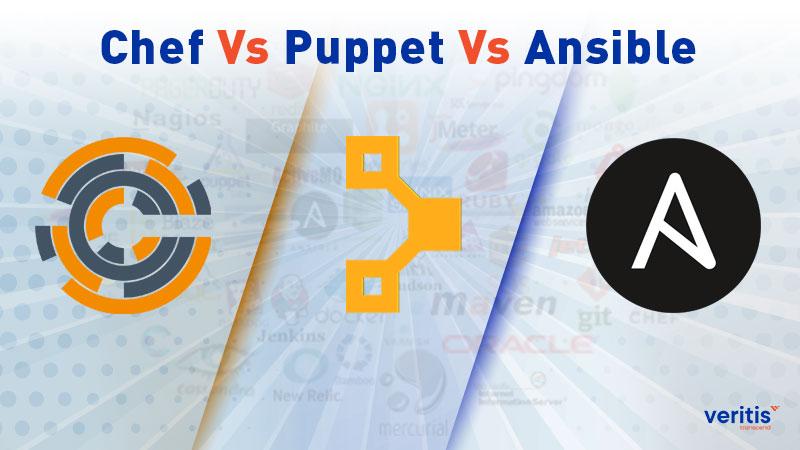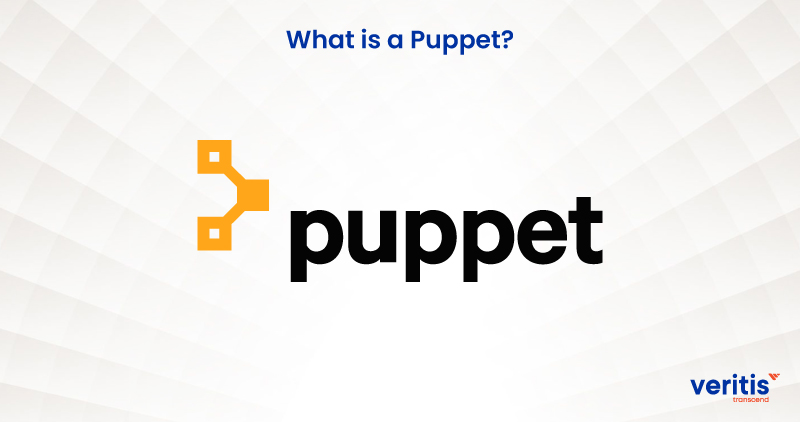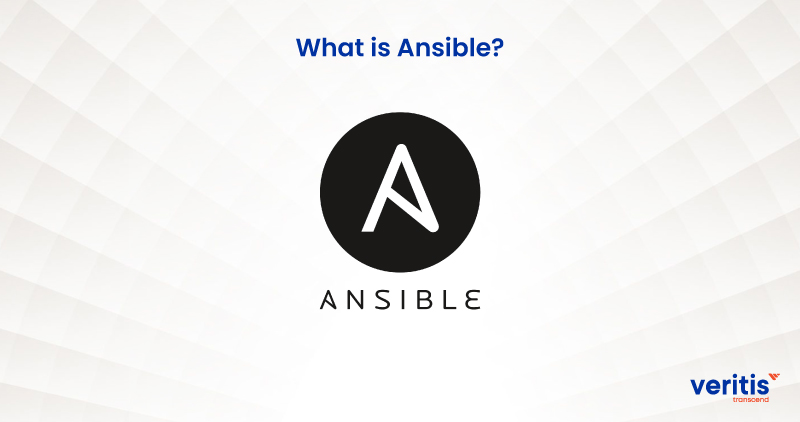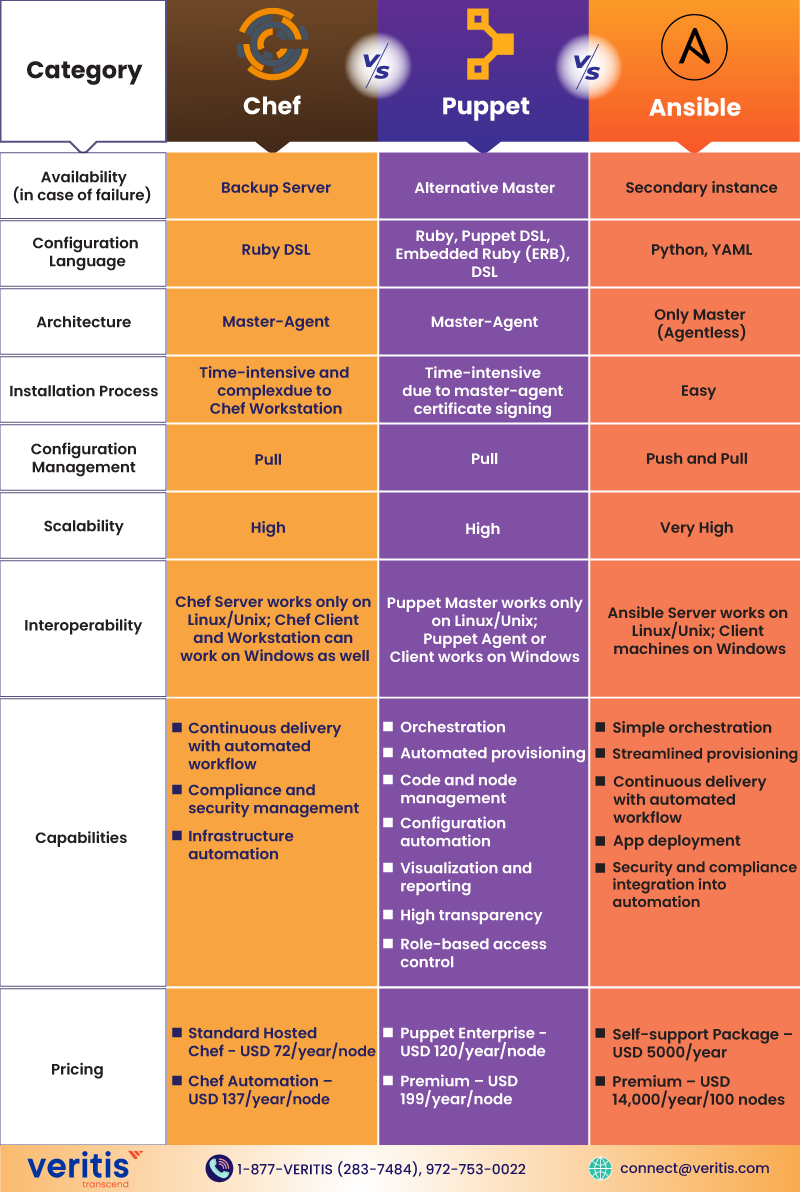
Chef Vs. Puppet Vs. Ansible, this is a dilemma that every organization has. Since DevOps has evolved rapidly and become part and parcel of every business function in the digital trend, this comparison is quite relevant and pressing. Many organizations are increasingly adopting the new collaborative culture to achieve a competitive edge in modern IT.
The global DevOps market size is projected to attain USD 14.97 billion by 2026 with a CAGR of 19.1% during the forecast period.
DevOps automates and monitors the software creation process, from integration, testing, and release to deployment and management. It has successfully laid down the path to taking the IT industry to the next level by facilitating many benefits, including faster delivery time, 100% customer satisfaction, quick fault detection, CI/CD, and high ROI.
According to research conducted by Global Newswire, there is an assessment of the Compound Annual Growth Rate (CAGR) of 18.95%, leading to a projected value of USD 12,215.54 million by 2026. The growth statistics are interesting; let’s delve into more of these to understand better.
Google’s data reveals that 86% of businesses emphasize the need to swiftly develop and launch new software, recognizing the value of DevOps. Furthermore, organizations capable of rapidly delivering digital products to consumers gain a competitive advantage. Additionally, Google’s research indicates that 77% of organizations currently employ DevOps for software deployment or plan to do so soon.
However, while every IT company finds ways and chalks out plans for effective DevOps implementation, many fail to meet expectations. Embracing the right DevOps platform or configuration management tools in DevOps is one of the significant challenges encountered in DevOps implementation.
Several of the latest DevOps configuration tools, such as Chef, Puppet, SaltStack, and Ansible, with various features available in the market. So, there is an inevitable need to compare Chef Vs. Puppet Vs. Ansible tools to identify the best tool for the success of DevOps projects.
What is a Chef?

Chef is a DevOps tool for configuration management, enabling automation and testing and streamlining infrastructure deployment through code. It employs a client-server architecture and boasts compatibility with various platforms such as Windows, Ubuntu, CentOS, and Solaris. Additionally, Chef integrates with popular cloud platforms like AWS, Google Cloud Platform, and OpenStack. Before delving into Chef in detail, it’s essential to grasp the concept of configuration management.
Configuration Management
Consider a scenario where you’re a systems engineer within an organization tasked with deploying or updating software and operating systems on hundreds of systems daily. While this can be accomplished manually, it often leads to multiple errors, potential software crashes during updates, and no straightforward way to revert to previous versions. Configuration Management tools in DevOps come into play to address these challenges.
Configuration Management involves a comprehensive record of an organization’s software and hardware information. It also automates tasks such as repairs, deployments, and updates across the entire application landscape. Configuration Management takes on the responsibilities of numerous system administrators and developers who manage numerous servers and applications. Some tools commonly utilized for Configuration Management include Chef, Puppet, Ansible, CF Engine, and SaltStack.
Why Choose Chef?
Consider a scenario where your office relocates to a different environment, and the task at hand is to have your system administrator install, update, and deploy software on hundreds of systems overnight. When this process is carried out manually, it’s susceptible to human errors, potentially leading to software malfunctions. This is where Chef comes into play as a powerful automation tool that translates infrastructure into code.
Chef streamlines application configuration, deployment, and management automation across the network, whether in a cloud or hybrid environment. It is an asset for expediting application deployment and enhancing software development speed, which denotes how rapidly software can adapt to new requirements or changing conditions.
Features of Chef
1) Effortless Management of Numerous Servers With Minimal Staffing: The Chef efficiently manages many servers with a small team of employees.
2) Compatibility With Various Operating Systems: Chef is compatible with multiple operating systems, including FreeBSD, Linux, Windows, and more.
3) Infrastructure Blueprint Maintenance: The Chef maintains a comprehensive blueprint of the entire infrastructure, ensuring visibility and control.
4) Seamless Integration With Major Cloud Service Providers: It seamlessly integrates with leading cloud service providers, enhancing its versatility and adaptability.
5) Centralized Management: Chef offers centralized management capabilities, with a single Chef server as the hub for deploying policies and maintaining consistency across the infrastructure.
Advantages of Using Chef
1) Streamlining Software Delivery: When you automate your infrastructure with Chef, software-related tasks such as testing and creating new environments for software deployments become significantly faster.
2) Enhanced Service Resilience: Automation through Chef enables proactive monitoring for bugs and errors, helping to prevent issues before they occur. It also facilitates quicker recovery from errors when they do happen.
3) Risk Mitigation: The Chef plays a crucial role in reducing conflicts throughout the development and production environments, thus lowering risks and enhancing compliance throughout the deployment process.
4) Cloud Readiness: Chef seamlessly adapts to cloud environments, simplifying the configuration, installation, and automatic management of servers and infrastructure in cloud-based setups.
5) Centralized Management: Chef’s versatility allows you to manage both your on-premise and cloud-based platforms, providing a unified approach to handling data centers and cloud environments.
6) Streamlined IT Operations and Workflows: Chef offers a continuous deployment pipeline that spans from building and testing to delivery, monitoring, and troubleshooting, helping to streamline IT operations and workflows.
Disadvantages of Chef
1) Steep Learning Curve: Chef comes with a significant learning curve, which may pose a challenge for newcomers to the platform.
2) Complex Initial Setup: The initial setup process can be intricate and demanding, requiring careful configuration and planning.
3) Absence of Immediate Actions on Change: The Chef cannot execute immediate actions on changes, as it primarily follows a pull-based process that adheres to predefined schedules.
What is Puppet?

Puppet is an effective system management tool that streamlines and automates configuration management.
It serves multiple purposes:
- Puppet functions as a software deployment tool.
- It offers open-source configuration management for server configuration, management, deployment, and orchestration.
- Puppet is tailored for the configuration management of Linux and Windows systems.
- It is crafted in Ruby and utilizes its unique Domain Specific Language (DSL) to define system configurations.
Configuration management involves maintaining software and computer systems (including servers, storage, and networks) in a known, desired, and consistent state. Additionally, it provides access to an accurate historical record of system states, which is valuable for project management and auditing.
In the market, you’ll find two primary versions of Puppet:
1) Open-Source Puppet: This version represents the primary iteration of the Puppet configuration management tool. Under its licensing, it operates with the Apache 2.0 license and is available for download from Puppet’s official website.
2) Puppet Enterprise: It is specially designed for enterprises. This is a paid version that offers robust node management capabilities. It includes compliance reporting, orchestration, role-based access control, a graphical user interface (GUI), API support, and command-line tools for effective node management.
Configuration Management
Configuration management is a systematic approach to implementing necessary changes in a system to maintain its long-term integrity. It achieves this without relying solely on the developers’ knowledge, ensuring a deterministic representation of the current system’s design and build state. By effectively recording the system’s state, it simplifies the auditing process. Configuration management addresses the following challenges:
1) Reverting to Previous Versions: In cases where an incorrect or skewed new component version is introduced, configuration management allows for the successful reversion to a prior, stable component version.
2) Adapting to Changing Requirements: It facilitates determining which components need to be modified when there are changes in system requirements, ensuring that the system remains aligned with evolving needs.
3) Recreating Implementations: When requirements have evolved significantly since the last implementation, configuration management enables the efficient redoing of the implementation to align with the updated requirements.
How Does Puppet Work?
The Puppet workflow follows a straightforward process. At its core is the Puppet master, which serves as the central server housing configuration data for various nodes it manages through manifests. Puppet agents are installed on these nodes and collect node-specific information using facts. These facts are sent back to the Puppet master.
With all the gathered data, the Puppet master constructs a catalog outlining node configurations. Subsequently, the Puppet master dispatches these catalogs to the agents. Agents utilize these catalogs and their collected information to implement configuration changes on their respective nodes. After making these updates, agents report back to the Puppet master.
Features of Puppet
1) Declarative Language: Puppet uses a declarative language for defining configurations, making it easy to specify the desired state of systems without specifying the steps to achieve it.
2) Cross-Platform Compatibility: Puppet is platform-agnostic and can manage configurations across various operating systems, simplifying multi-platform infrastructure management.
3) Centralized Configuration Management: Puppet centralizes configuration information on a Puppet controller server, allowing efficient management of configurations for multiple nodes from a single location.
4) Resource Management: Puppet manages system resources (e.g., files, packages, services) and ensures they remain desired, providing consistency and reliability.
5) Extensibility: Puppet can be extended through custom modules and plugins, enabling users to adapt it to their specific configuration and automation needs.
Advantages of Puppet
1) Efficient Automation: Puppet offers significant advantages in terms of automation. One notable feature is its ability to automate operating system management on remote machines, eliminating the need for manual intervention when deploying new versions or updates. This automation streamlines processes, reducing the potential for human error.
2) Accelerated Deployment: Automation greatly enhances deployment speed, relieving network engineers from time-consuming tasks. In the absence of automation, changes could take days or even weeks to implement due to complex manual processes. Puppet’s automation capabilities expedite deployment, freeing time for other essential tasks, such as software development and client interactions.
3) Ease of Use: Puppet is designed with user-friendliness in mind, making it accessible for administrators. While it simplifies many tasks, technical support is available for resolving issues and providing guidance. Leveraging Puppet’s technical support can prevent costly mistakes and ensure quick issue resolution, saving both time and money.
4) Consistency and Standardization: Puppet enforces consistency in system configurations, reducing the risk of compatibility issues arising when each specialist writes code according to their style. This standardization enhances system reliability and stability.
5) Scalability: Puppet scales effectively, making it suitable for managing configurations across large and complex infrastructures. Whether you have a handful of servers or a vast network, Puppet can adapt to your needs.
Disadvantages of Puppet
1) Puppet Server Vulnerability: The centralized nature of Puppet also presents certain drawbacks, with server security being a primary concern. If malicious actors access the Puppet server, they can manipulate client operating systems, potentially issuing commands to encrypt or delete data. The consequences of such breaches can be immeasurable. Implementing modern security mechanisms to safeguard the server against external threats is crucial to mitigate this risk, with a strong emphasis on adhering to fundamental information security principles.
2) Administrator Expertise: Effectively maintaining extensive networks demands highly skilled and attentive administrators. For instance, a simple mistake when configuring a system file, if not thoroughly checked, can have widespread negative repercussions across multiple servers simultaneously. While it’s possible to revert systems to their previous configurations, any downtime or data loss can result in financial setbacks for the organization. Moreover, ensuring network specialists possess the necessary training and qualifications may incur substantial costs.
What is Ansible?

Ansible is an open-source, cross-platform automation tool DevOps professionals use to automate resource provisioning. It’s widely employed to deliver continuous software code through “infrastructure as code.”
Ansible, a leading enterprise automation solution, operates on Unix-like platforms, managing various systems, including Unix and Microsoft architectures. It’s agentless, automating tasks over SSH or Windows Remote Management connections. Ansible improves IT infrastructure efficiency, scalability, and reliability.
Designed for IT professionals, it simplifies tasks like app deployment, system integration, and service coordination in complex IT environments. Automation streamlines activities, saving time and boosting productivity.
Ansible is a versatile tool suitable for both automation experts and everyday developers. It facilitates rapid configuration of entire networks, supporting tasks like software installation, daily task automation, infrastructure provisioning, security enhancement, compliance management, and widespread enterprise automation.
How Does Ansible Work?
Ansible sends modules to interact with networks and automate tasks, ensuring systems operate as desired. It’s agentless, so no software is needed on controlled nodes. The management node orchestrates Playbook execution, establishing SSH connections, deploying modules, and cleaning up. Ansible scripts, created in Python, connect to remote hosts through SSH. Inventory data specifies the machines to manage, with a customizable inventory file. Ansible uses SSH to link with servers, execute tasks, and deliver modules, all driven by human-readable YAML templates for efficient automation.
Features of Ansible
1) Agentless Operation: Ansible operates without requiring software installation on managed machines, reducing the risk of faults and cybersecurity threats. It manages master-agent interactions via standard SSH or the Paramiko module, ensuring efficient resource utilization and lower maintenance costs.
2) Python Support: Ansible can be used through its Python API, allowing control of nodes, response to Python events, plugin development, and data import from external sources. Ansible is built in Python, simplifying installation and operation.
3) SSH Security: Ansible relies on secure SSH for communication, eliminating the need for passwords and enhancing security. It connects to clients over SSH, pushes modules to clients, executes them locally, and receives results back.
4) Push Architecture: Ansible employs a push-based architecture where settings are simultaneously written and pushed to nodes. This enables rapid configuration changes across multiple servers, enhancing efficiency and control.
5) Ease of Setup: Ansible simplifies tasks through playbooks, roles, inventories, and variable files, allowing for organized and specific task execution. It streamlines automation for system configuration, software installation, continuous delivery, and zero downtime deployments.
Advantages of Ansible
1) Ease of Learning: Ansible is known for its simplicity, making it accessible for beginners and experienced professionals. Its straightforward approach lets users grasp its logic and workflow quickly, aided by comprehensive and easily interpretable documentation.
2) Python Language: Ansible is built on Python, a human-readable language widely popular among engineers and system administrators. The presence of Python libraries on most Linux distributions simplifies Ansible’s setup and operation.
3) No Agent Dependency: Ansible’s agentless nature eliminates the need for agents to be installed on remote systems. It manages communications via SSH or the Paramiko module, reducing maintenance overhead and performance degradation.
4) YAML Playbooks: Ansible uses YAML for writing Playbooks and its configuration files. YAML is highly suitable for configuration management tools in DevOps and automation, offering readability, support for comments, and anchors for referencing other items.
5) Ansible Galaxy: Ansible Galaxy is a central repository for discovering, reusing, and sharing Ansible-related content. It streamlines the process of downloading reusable Roles for tasks like application installation and server configuration, enhancing deployment speed and efficiency.
Disadvantages of Ansible
1) Basic User Interface: Ansible initially lacked a graphical user interface (GUI), relying solely on the command line. While it has since introduced web-based interfaces like AWX and Ansible Tower, they still require improvement. The GUI interfaces cover about 85% of tasks achievable through the command line, and synchronization issues between GUI and CLI actions can lead to conflicting results.
2) Lack of State Management: Ansible lacks a concept of state, unlike some other automation tools like Puppet. It doesn’t track dependencies or maintain a detailed catalog of configurations, making it less suitable for scenarios requiring strict state management.
3) Limited Windows Support: Ansible offers limited support for Windows. Although it can manage Windows hosts, it relies on native PowerShell remoting rather than SSH, necessitating a Linux control machine for managing Windows hosts. This limitation hinders seamless cross-platform management.
At this very juncture, we compare the top configuration tools, including Chef, Puppet, and Ansible.
Chef vs Puppet vs Ansible – What are the differences?
The three configuration tools are simple yet facilitate robust capabilities to automate complex multi-tier IT application environments.

Email-us: connect@veritis.com; Call: 972-753-0022
The distinctive difference between Ansible vs Puppet vs Chef is the underlying script. While Puppet is coded in Ruby, Ansible utilizes Python and YAML scripts, and Chef is built on Ruby like Puppet. However, in the Puppet Vs. Chef bout differs from Puppet as it is programmed on Ruby combined with Domain Specific Language. The other differences in Chef Vs. Puppet Vs. Ansible are portrayed based on different factors, including Availability, Configuration Language, Setup and Installation, Ease of Management, Scalability, Interoperability, Tool Capabilities, and Pricing.
1) Availability
The three configuration tools, Chef, Puppet, and Ansible, are very available in the event of a main master or server failure. Every tool has the facility of a backup server or an alternative master to render support in case of a main server failure.
| DevOps Tool | Availability (in case of server failure) |
| Chef | Backup Server |
| Puppet | Alternative Master |
| Ansible | Secondary instance |
2) Configuration Language
As indicated earlier, the configuration language in the IT automation tools is one of the most distinctive differences. Configuration language plays a prominent role in determining the applications of configuration management tools in DevOps.
| DevOps Tool | Configuration Language | Suitable for | Learning Level |
| Chef | Ruby DSL | Developers | Difficult |
| Puppet | Ruby, Puppet DSL, Embedded Ruby (ERB), DSL | System Administrators | Difficult |
| Ansible | Python, YAML | System Administrators | Simple |
3) Setup and Installation
When it comes to ease of setup and installation, Ansible dominates the other two tools, Chef and Puppet, as it has an ‘agentless’ architecture. Chef and Puppet follow master-agent or master-slave architecture.
| DevOps Tool | Architecture | Ease of Setup and Installation |
| Chef | Master-Agent | Difficult and complex due to Chef Workstation |
| Puppet | Master-Agent | Difficult due to certificate signing between master and agent |
| Ansible | Only Master (Agentless) | Easy |
4) Ease of Management
The management of the DevOps automation services depends upon the language and configuration of the tools. There are two types of configurations, including ‘pull’ and ‘push’. A pull configuration involves pulling all configurations from a central server to the slave nodes without any commands. In a push configuration, all the configurations in the server are pushed to the nodes with specific commands.
Regarding configuration language, YAML is considered the easiest one as it is similar to English and is human-readable. While Puppet DSL and Ruby DSL languages create setbacks for management.
Once again, Ansible demonstrates its dominance over the others in terms of management, as it supports the YAML language and follows both push and pull configurations.
| DevOps Tool | Configuration | Ease of Management |
| Chef | Pull | Difficult |
| Puppet | Pull | Difficult |
| Ansible | Push and Pull | Easy |
5) Scalability
Scalability of the configuration tools is one of the main factors enterprises consider before choosing the tool.
Chef, Puppet, Ansible can manage large infrastructures while handling the burden of scaling configurations. However, there is a slight difference between them in terms of scalability owing to the complexity of their configuration language.
| DevOps Tool | Scalability |
| Chef | High |
| Puppet | High |
| Ansible | Very High |
6) Interoperability
In terms of interoperability, all three tools, Chef, Puppet, Ansible, have similar features. In three cases, all the servers work on Linux or Unix machines, while slaves or nodes will work on Windows machines.
| DevOps Tool | Interoperability |
| Chef | Chef Server should be on Linux/Unix; Workstation and Chef Client support Windows |
| Puppet | Puppet Master should be on Linux/Unix; Puppet Agent or Client supports Windows |
| Ansible | Ansible Server should be on Linux/Unix; Client machines support Windows |
7) Tool Capabilities
Reviewing the product capabilities in AnsibleVs Chef Vs Puppet can help you choose the most suitable tool for your requirements. Each tool has its own set of better capabilities.
| Product Capabilities | ||
| Chef | Puppet | Ansible |
|
|
|
8) Pricing
Pricing plays a prominent role in decision-making for adopting configuration management tools or, in general, any product or technology.
| DevOps Tool | Pricing | Pricing |
| Chef | High | USD 13700/year for up to 100 nodes |
| Puppet | Medium | USD 11200-19900/year for up to 100 nodes |
| Ansible | Low | USD 10000/year for up to 100 nodes |
In Conclusion
All three tools, including Chef, Puppet, and Ansible, have advantages and are better. Each tool takes a slightly different approach to automation and is suitable for specific user segments in the same target space. To choose the best configuration management tools in DevOps, the organization must consider various technical and business aspects, including architecture, features, usability, and support.
When comparing the DevOps configuration management tools – Chef, Puppet, and Ansible each has strengths and suitability for various scenarios. Chef offers flexibility and a strong focus on infrastructure as code, Puppet excels in managing large-scale environments, while Ansible stands out for its simplicity and agentless approach.
Selecting the tool that best aligns with your organization’s specific needs and objectives. Veritis, recognized with prestigious awards such as the Stevie Award and Globee Business Awards, offers expert services to help you navigate and implement these tools effectively, ensuring seamless integration into your DevOps practices.
Got Questions? Schedule A Call Explore DevOps Services
[WPSM_AC id=13641]
Related Stories:
